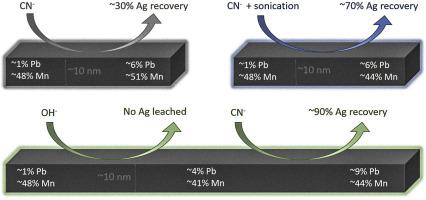Hydrometallurgy ( IF 4.8 ) Pub Date : 2020-12-29 , DOI: 10.1016/j.hydromet.2020.105544 Gonzalo Larrabure , Sheyla Chero-Osorio , Dhamelyz Silva-Quiñones , Carsten Benndorf , Mackenzie Williams , Fei Gao , Carlos Gamarra , Alejandro Alarcón , Carlos Segura , Andrew Teplyakov , Juan Carlos F. Rodriguez-Reyes

|
Leaching of polymetallic sulfides is often challenging due to the complexity of these systems. The main issues are related to the formation of surface by-products or to the presence of different metals that require a greater consumption of chemicals compared to that needed to extract the target metal during leaching. This latter case is followed in the present work using X-ray photoelectron spectroscopy (XPS) during the leaching of a silver-containing polymetallic (Mn-Fe-Pb) sulfide under three different cyanidation procedures: (1) conventional leaching, (2) ultrasound-assisted leaching, and (3) leaching of a sample pretreated in alkaline media. In all cases, leaching results in the build-up of Pb compounds (oxides/hydroxides) on the surface of the minerals, suggesting a mechanism in which Pb is first leached by hydroxide and cyanide and later is re-adsorbed as an external layer on the minerals. On the other hand, the effect of each process on Mn was quite distinct: 1) Conventional leaching leads to the oxidation of the sulfide (pyrite) surface and a slight increase of surface Mn species; 2) Ultrasound-assisted leaching decreases surface Mn by dissolving oxidized species, which exposes fresh sulfide surfaces and increases Ag extraction; and 3) An alkaline pretreatment at high temperature exposed fresh sulfide surfaces and decreased the surface concentration of Mn. The fact that ultrasound-assisted leaching and leaching after an alkaline pretreatment allow for a higher Ag extraction (60% and 75% of total Ag, respectively, as opposed to the 25% extracted via conventional leaching), indicates that leaching is more efficient if the surface is not oxidized and if Mn is removed from the samples, either before or during leaching.
中文翻译:

多金属(Mn-Fe-Pb)硫化物的表面过程在超声处理和碱性预处理下经受氰化物浸出:通过X射线光电子能谱(XPS)了解银提取的差异
由于这些系统的复杂性,多金属硫化物的浸出通常具有挑战性。主要问题与表面副产物的形成或与不同金属的存在有关,与浸出过程中提取目标金属所需的化学物质相比,这些金属需要更多的化学物质消耗。在本工作中,在三种不同的氰化步骤中浸出含银多金属(Mn-Fe-Pb)硫化物期间,使用X射线光电子能谱(XPS)跟踪后一种情况:(1)常规浸出,(2)超声波辅助浸出,以及(3)浸出在碱性介质中预处理过的样品。在所有情况下,浸出都会导致矿物质表面积聚Pb化合物(氧化物/氢氧化物),提示了一种机制,其中Pb首先被氢氧化物和氰化物浸出,然后被重新吸收为矿物上的外层。另一方面,每个过程对锰的影响是非常不同的:1)常规浸出导致硫化物(黄铁矿)表面氧化,表面Mn种类略有增加;2)超声辅助浸出通过溶解氧化物质降低表面锰,从而暴露出新鲜的硫化物表面并增加银的提取。3)高温下的碱预处理暴露了新鲜的硫化物表面并降低了Mn的表面浓度。超声辅助浸提和碱预处理后浸提可以提高更高的Ag提取率(分别占总Ag的60%和75%,而通过传统浸提法提取的25%),











































 京公网安备 11010802027423号
京公网安备 11010802027423号